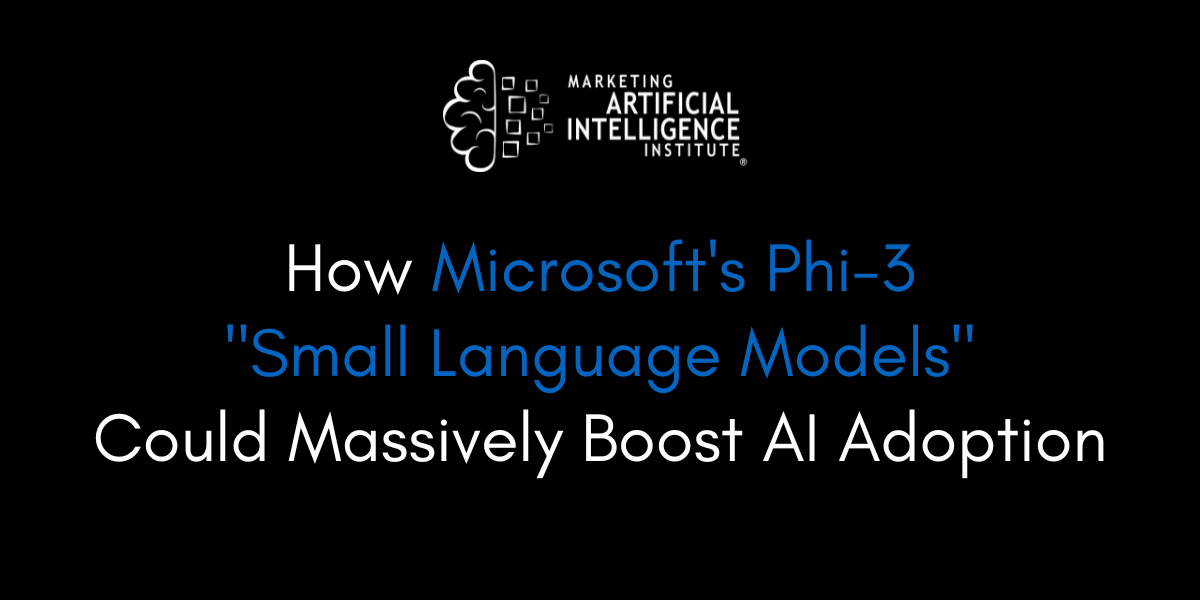Microsoft is out to make the point that bigger isn't always better in AI...
The company just announced its Phi-3 family of open models, which are noteworthy because they're, well, small.
A family of "small language models" or SLMs, Phi-3's models offer many of the same capabilities as large language models, but with one catch:
They don't need as much compute and data to do what they do.
For instance, Phi-3-mini, one of the main models in the family, performs better than models twice its size, says Microsoft.
SLMs aren't designed to replace LLMs. But they open up a range of use cases for companies—and on devices—where size matters.
In the process, they could transform AI adoption in business as we know it.
How?
I got the answer from Marketing AI Institute founder / CEO Paul Roetzer on Episode 95 of The Artificial Intelligence Show.
Small Language Models offer another way to scale
"The reason why these models are important is because it costs a lot of money to run the big models," says Roetzer.
Training massive frontier models like GPT-4, GPT-5, Gemini 1.5, or Claude3 Opus costs hundreds of millions or even billions of dollars.
But the costs don't stop there.
Every time a user interacts with the model to write an email, generate an image, or create a video, there are "inference costs" to run the model.
These costs are incurred any time you use a large model to perform a task. Which means any company (like Microsoft) that uses these models for their AI tools racks up costs quickly.
"So there's a lot of motivation to build these smaller models that don't cost as much money," says Roetzer.
Phi-3 appears to show that SLMs can perform as well as LLMs on some tasks, making them a potentially viable replacement in some scenarios.
That opens up lots more options for AI builders and companies using their technology.
In the Phi-3 announcement, Microsoft's Sonali Yadav writes:
“What we’re going to start to see is not a shift from large to small, but a shift from a singular category of models to a portfolio of models where customers get the ability to make a decision on what is the best model for their scenario."
And they could enable local AI right on your phone
This begins to get really interesting for your average consumer when you pair SLMs with phones.
Apple has released research papers indicating that small models may be able to run locally on devices and, if properly trained, match the performance of much larger models.
"In the future, you could be on your device on Do Not Disturb or Airplane mode. And you could be running a model doing something on your phone," says Roetzer. "That's what this means."
On-device AI models could be a major catalyst for increased adoption.
Done right, Roetzer predicts AI will become even more invisibly embedded in our everyday tools and devices. (Like how AI powers things like Netflix and Spotify without users ever thinking about it.)
"That's what this will enable," he says. "These models can just be underlying functions on your phone and you don't even know you're using AI. It's just going to be embedded within everything.
Mike Kaput
As Chief Content Officer, Mike Kaput uses content marketing, marketing strategy, and marketing technology to grow and scale traffic, leads, and revenue for Marketing AI Institute. Mike is the co-author of Marketing Artificial Intelligence: AI, Marketing and the Future of Business (Matt Holt Books, 2022). See Mike's full bio.



